Down To Earth (01–15 June, 2025)
The following topics are covered in the Down To Earth (01–15 June, 2025):
Electric Vehicles in India
Context
- Electrifying vehicle fleets is no longer a futuristic goal in India, it’s an urgent necessity.
About the Electric Vehicle in India
- India is witnessing a significant transformation in its transportation sector with the rapid adoption of electric vehicles (EVs).
- It is driven by environmental concerns, energy security, and economic sustainability.
Growth of EV Sales and Market Trends
- India has seen exponential growth in EV sales, particularly in the two- and threewheeler segments.
- In 2024, electric cars accounted for just 2% of new car sales, but this figure is expected to rise to nearly 15% by 2030.
India's EV Ambitions vs Reality
- In 2019, NITI Aayog set ambitious 2030 targets:
- 70% commercial cars
- 30% private cars
- 40% buses
- 80% two- and three-wheelers
- As of mid-2025:
- Only three-wheelers show strong adoption (~60% EVs)
- EV penetration in other categories remains around 5–6%
Significances of EVs
- Tackling Climate Change: The transport sector contributes ~15% of global CO₂ emissions.
- Oil dependency (petrol and diesel) is a major driver of this pollution.
- Electric vehicles (EVs) powered by renewable energy present a cleaner alternative.
- Reducing Local Air Pollution: Urban areas suffer from toxic air pollution, primarily from fossil-fuel vehicles.
- EVs can significantly cut harmful emissions in cities. It has direct health and quality-of-life benefits.
- Saving Foreign Exchange: Countries like India spend vast sums on oil imports.
- EV adoption can reduce this burden, improving national economic resilience.
Global Export Dominance
- China topped global electric vehicle (EV) exports in 2024, according to the Global EV Outlook 2025 by the International Energy Agency (IEA).
- In all five emerging markets studied—Brazil, India, Indonesia, Mexico, and Thailand— Chinese OEMs offered EVs at lower prices than the average electric car, boosting adoption.
Government Initiatives and Policies
- FAME India Scheme (Phase II): It aims to support the electrification of public and shared transportation.
- E-Vehicle Policy: It encourages global EV manufacturers to invest in India, boosting domestic production and reducing reliance on imports.
- PM E-DRIVE: It has played a crucial role in supporting commercial EV adoption, particularly in the three-wheeler segment.
- Charging Infrastructure Expansion: As of mid-2024, India had over 16,000 public charging stations, significantly improving accessibility for EV users.
Way Forward: Integrate Clean Air and Mobility Goals
- The National Clean Air Plan (NCAP) needs to:
- Prioritize both cleaner vehicles and fewer vehicles
- Focus on public transport expansion and ridership
- Measure modal share, not just number of EV buses
MGNREGA Struggles to Deliver Jobs Despite Surge in Registrations
Context
- A recent report by LibTech India highlights a troubling disconnect in the MGNREGA: while registrations have increased by 8.6%, actual employment generation has declined by 7.1%.
Key Findings from the Report
- Registrations Increased: The number of households seeking work under MGNREGA rose from 13.80 crore (FY24) to 14.98 crore (FY25).
- Employment Declined: Despite higher demand, only 7% of households received the full 100 days of guaranteed work.
- Budget Shortfalls: The government allocated ₹86,000 crore, but actual spending exceeded ₹82,963 crore, highlighting funding constraints.
- Regional Disparities: States like Odisha (- 34.8%), Tamil Nadu (-25.1%), and Rajasthan (-15.9%) saw a decline in employment, while Maharashtra (+39.7%) and Bihar (+13.3%) reported increases.
Key Features of MGNREGA (2005)
- Employment Guarantee:Ensures 100 days of wage employment to rural households.
- Funding Structure: 90:10 (Centre & State Government)
- Budget allocations vary based on demand.
- Legal Entitlement: Workers have a legal right to employment under the Act.
- Compensation is provided if work is not assigned within 15 days of demand.
- Wage Payment & Worksite Facilities: Wages must be paid within 15 days of work completion.
- Worksites must provide basic facilities like drinking water, shade, and first aid.
Key Objectives
- Asset Creation: Focuses on durable and productive rural assets such as water conservation structures, roads, and irrigation facilities.
- Social Inclusion: Prioritizes employment for women, Scheduled Castes (SCs), and Scheduled Tribes (STs).
- Decentralized Planning: Strengthens Panchayati Raj Institutions (PRIs) by involving them in planning and implementation.
Implementation & Impact
- Nationwide Coverage: Initially launched in 200 districts in 2006, it was later expanded to cover all rural districts.
- Women’s Participation: Women’s involvement in MGNREGA has risen from 48% in FY 2013-14 to over 58% in FY 2024-25.
- Rural Asset Development: Over 8.07 crore rural assets have been created under the scheme.
Challenges Affecting MGNREGA
- Delayed Wage Payments: Workers often face months-long delays in receiving wages, violating the legal mandate of payment within 15 days.
- Aadhaar-Based Payment Issues: Over 27.5% of workers remain ineligible for AadhaarBased Payment System (ABPS), leading to exclusion from work.
- Job Card Deletions: 11.6 million job cards were deleted in FY25, raising concerns about accessibility.
- Insufficient Budget Allocation: Experts argue that the ₹86,000 crore budget is inadequate, recommending an increase to ₹1.5–2 lakh crore.
Way Forward
- Timely budget revisions to ensure adequate funding.
- Streamlining wage payments to improve worker participation.
- Better monitoring mechanisms to track employment trends and prevent exclusions.
Rice For Ethanol Production
Context
- Recently, the Union Government has approved an additional 2.8 million tonnes of Food Corporation of India (FCI) rice for ethanol production under the Ethanol Blended Petrol (EBP) Programme, raising the total allocation to 5.2 million tonnes for the 2024–25 ethanol supply year.
Key Highlights of the Decision
- Total Rice Allocation for Ethanol (2024–25): 5.2 million tonnes.
- Additional Allocation Approved: 2.8 million tonnes.
- Issue Price of FCI Rice for Distilleries: ₹22.50 per kg.
- Ethanol Conversion Rate: 470 litres per tonne.
- Expected Ethanol Output: ~2.45 billion litres.
Government’s Rationale
- The decision follows an evaluation of buffer stock levels and potential ethanol yields from surplus FCI grain.
- The government aims to achieve 20% ethanol blending in petrol by 2025–26, reducing fossil fuel dependence and carbon emissions.
Concerns Over Food Security
- Impact food availability for vulnerable populations, as India’s ethanol program increasingly relies on rice, sugarcane, and maize.
- Increase market prices of rice.
- Affect livestock feed supplies, as rice is a key component.
Alternative Biofuel Approaches
- Experts suggest shifting focus to second-generation (2G) biofuels, which use agricultural waste and non-food biomass instead of edible grains.
- While 2G ethanol is more sustainable, it remains technologically costlier.
Ethanol Blended Petrol (EBP) Programme
- It is an initiative by the Indian government aimed at blending ethanol with petrol to reduce dependence on fossil fuels and enhance energy security.
- It has been progressively expanded across India, excluding the Union Territories of Andaman & Nicobar and Lakshadweep.
Key Aspects
- Ethanol Blending Targets: The government has set ambitious targets, aiming for 20% ethanol blending by 2025, advancing the previous goal from 2030.
- Raw Materials for Ethanol Production: Ethanol can be produced from various sources, including sugarcane juice, sugar syrup, damaged food grains like wheat and rice, and molasses.
- Economic & Environmental Benefits: The programme helps reduce carbon emissions, supports farmers by creating additional demand for agricultural produce, and lowers reliance on imported crude oil.
- Policy Interventions: Measures such as tax reductions, financial assistance for ethanol production, and long-term procurement policies have been implemented to boost ethanol production.
Ecotourism Zone Around Tiger Reserve in India
Context
- Villages near Jim Corbett Tiger Reserve oppose plans to open yet another ecotourism zone in light of rising attacks by the big cats.
Rise of the ‘Eco’ in Tourism
- The National Tiger Conservation Authority (NTCA) estimates that over 60% of protected areas in India now have designated ecotourism zones, primarily in the buffer areas of reserves like Corbett (Uttarakhand), Kanha (Madhya Pradesh), and Tadoba (Maharashtra).
- It aims to promote low-impact tourism that funds conservation, provides alternative livelihoods, and enhances visitor awareness.
- The Supreme Court of India, in 2012, banned tourism in core areas of tiger reserves temporarily.
- NTCA issued guidelines in 2012 and revised them in 2018, encouraging ecotourism only in buffer zones while protecting core critical tiger habitats.
Community at the Core – Or Sidelines?
- The essence of ecotourism lies in community benefit. In reserves like Periyar in Kerala, local eco-development committees (EDCs) manage boat rides and guided treks, ensuring that 70-80% of revenue is ploughed back into local households.
- However, these models are the exception, not the rule. In Tadoba, rapid commercialization has left local communities behind.
- A 2021 study by the Centre for Ecological Sciences (IISc Bangalore) found that less than 20% of ecotourism revenue reaches local stakeholders across central Indian tiger reserves.
- A positive example comes from Valmiki Tiger Reserve (Bihar), where the forest department partners with Tharu tribals to run eco-lodges and guided forest walks — providing over 200 local jobs annually, with zero reported conflict in recent years.
Way Forward: Sustainable and Accountable
- Community Governance: Empowering local EDCs with decision-making power, profitsharing mechanisms, and capacity building.
- Ecological Audits: Annual assessments of tourism impacts — including vehicle density, waste, water consumption, and biodiversity metrics.
- Zoning & Regulation: Defining ‘tourism-free corridors’, especially near core zones, and encouraging eco-certified accommodation only.
Seed Saviours: Preserving Indigenous Crops for Climate Resilience
Context
- Across India, community-led seed banks are quietly safeguarding indigenous crop varieties, ensuring food security and climate resilience.
About
- Seed banks managed by communities and non-profits are repositories of hundreds of indigenous climate-resilient crop varieties but need help in storage, technical aid and policy support to thrive.
- Community seed banks and non-profits across India store hundreds of climateresilient crop varieties that can ensure food security.
Traditional Resources
- Drought Resistant (Survives With Minimal rainfall & Ideal For Drylands):
- Rice: Navara, Nadan Kuruva, Rakta Sali, Lal Kada, Ganda Bhat, Jeere, Daptari, Ambamor, Kalabati, Kalubhat (100 days), Mohmaya, Golden Navra, Chapure, Salim Sana, Basumati, Chinamali
- Finger Millet: Bhadaee, Lapadwa
- Grass Pea: Dhelahwa
- Pigeon Pea: Maghara, Ramrahriya
- Pulses: Sarukhundabiri, Mankadadanti, Laha Kankadadandi, Baragadi, Tula Baragadi
- Oilseeds: Jada, Dhalasorisha, Sesame (Kholsa)
- Bottle Gourd: Tumda Dudhi, Davli Dudhi, Tarpu Dudhi
- Millets: Bhalu, Bhati, Mami, Janhara, Kuiri, Suan, Khupamandia, Badamandikhuamandia, Haladiamaka
- Tuber: Narangi Haladi
- Maize: Pirwa, Sathiva, Chaurwa
- Wind Resistant:
- Rice: Paunchhi
- Disease/Pest Resistant:
- Rice: Dhan-Hajini, Silki, 6444, Chittimutyalu, Bahuroopi
- Field Bean: Nalla Bebbari
- Green Gram: Chamki Pesari
- Oilseeds: Budha Sorisha
- Tuber: Baralendisaru
- Millets: Bhalu,Bhati, Mami, Janhara, Khupamandia, Kuiri, Suan, Badamandikhuamandia, Haladiamaka
- Salinity Resistant:
- Millets: Bhalu, Bhati, Mami, Janhara, Rakta Sali, Khupamandia, Kuiri, Suan, Badamandikhuamandia, Haladiamaka
- Rice: Rakta Sali
- Heat Resistant:
- Finger Millet: Bhadaee, Lapadwa
- Pigeon Pea: Maghara, Ramrahriya
- Bottle Gourd: Tumda Dudhi, Davli Dudhi, Tarpu Dudhi
- Millets: Bhalu,Bhati, Mami, Janhara, Khupamandia, Kuiri, Suan, Badamandikhuamandia, Haladiamaka
- Rice: Kala Batti, Navara, Kalabati, Lal Kada, Kalubhat (100 days), Basmati, Mohmaya, Manipuri, Golden Navra, Chapure, Salim Sana
- Flood Tolerant:
- Green Gram: Ganga Pesari
- Wheat: Bansi
- Rice: Rakthasali, Kuttadan, Padeya, Amaghawad, Gajmukta, Lal Kada, Dudhmalai, Devbhog, Kariyakamat, Gola kushund, Kalabhat
Reviving Traditional Seed Banks
- Women farmers in Telangana established the Sangham Seed Bank in 1995, supported by the Deccan Development Society.
- Today, it stores 80 types of traditional food crops, including millets, pulses, and oilseeds, which grow well in dry, tough conditions.
- Similarly, in Madhya Pradesh’s Neemuch conserves native seeds such as tomato, brinjal, pearl millet, wheat, and perennial pigeon pea that are stored using traditional methods, ensuring their longevity without chemical preservatives.
- In Odisha’s Nayagarh district, the Raisar Community Indigenous Seed Bank has been preserving cowpea varieties such as Ranga Baragadi, Batula Chana, Sarukhunda Biri, and Mankada Danti.
- Karnataka’s Janadhanya Seed Network grows pest-resistant and drought-tolerant cowpea.
Challenges in Seed Conservation
- Lack of formal recognition: Many operate informally, making it difficult to access funding.
- Storage limitations: Traditional preservation methods need technical support to improve longevity.
- Policy gaps: There is no centralized database tracking the number and types of seeds stored by these banks.
Artificial Pollination in India: A Cause of Concern
Context
- India is undergoing a pollinator crisis, with declining populations of bees and other pollinating species severely affecting crop yields.
- In several states, farmers now rent bees or resort to manual pollination to secure harvests, raising concerns about long-term sustainability.
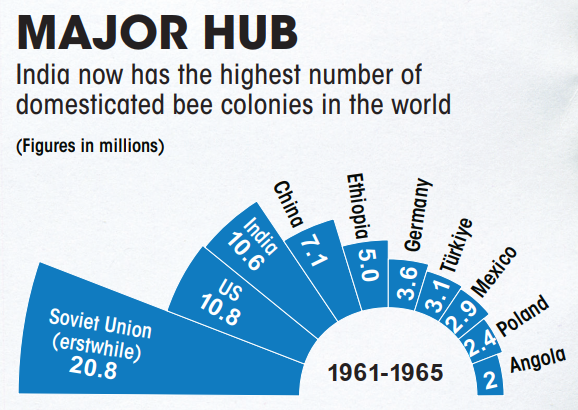
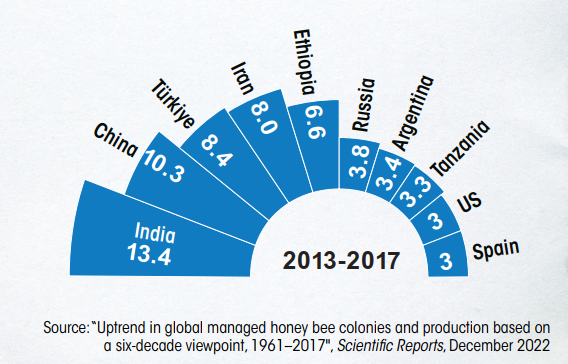
Importance of Pollinators
- Pollinators like bees, butterflies, wasps, and bats are vital for:
- One-third of global food crops;
- 85% of cultivated crops, including fruits, vegetables, nuts, and oilseeds;
- Livelihoods and biodiversity, especially in developing countries;
- Causes of the Crisis: Pollinators are vanishing due to:
- Intensive farming and monocropping;
- Pesticide use;
- Climate change and rising temperatures
- Habitat loss and pollution
- Alarming Data:
- 71% of pollinator species have declined globally; 3.4% extinct in two decades
- 30% of island-based species at risk (IUCN)
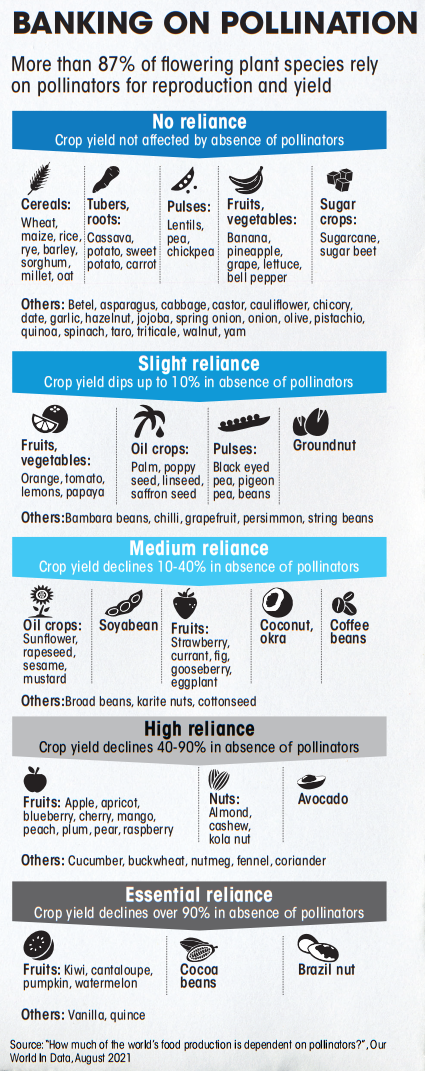
- Up to 90% hive losses in parts of the US due to colony collapse disorder
- India’s Worrying Trends:
- Studies in Odisha and Bengaluru show 70–90% bee species decline in some areas
- Wild bee populations are diminishing in the Himalayas, affecting crops like apples
- Pollinator scarcity is impacting highvalue crops including coffee, spices, fruits, and vegetables
Rise of Artificial Pollination
- Bee rentals: Beekeepers earn more from pollination than honey production.
- Manual pollination: Labour-intensive process now used for crops like coffee, vanilla, cardamom, oranges, and jasmine.
- Labour costs are high, and results are inferior to natural pollination
Regional Case Studies
- Janjehli Valley, Himachal Pradesh: Beekeepers earn up to ₹3 lakh in one flowering season from hive rentals.
- Kodagu, Karnataka: Coffee growers employ teams for hand pollination.
- Bagalkot and coastal Karnataka: Over 60% of chilli and fruit farmers rely on manual pollination.
- Udupi: Jasmine growers report yield drop due to thermal plant pollution, now resort to hand pollination.
Concerns Surrounding Artificial Pollination
- Ecological Disruption: Artificial pollination does not replicate the natural biodiversity benefits provided by insects.
- High Labor Costs: Manual pollination is labor-intensive and expensive, making it unsustainable for small-scale farmers.
- Genetic Risks: Over-reliance on artificial methods may lead to reduced genetic diversity in crops, affecting resilience to diseases.
- Long-Term Sustainability: Experts warn that artificial pollination is a temporary fix, not a solution to the broader pollinator decline.
Way Forward: Reviving Natural Pollinators
- Beekeeping in Kerala-Karnataka border districts revived cashew yields
- Pollinator gardens, companion planting, and organic practices adopted in Melukote.
- Bumblebee domestication underway in Himachal for greenhouse pollination—more efficient than honeybees.
India’s Life Expectancy Dips for the First Time in Five Decades
Context
- India has witnessed a decline in life expectancy for the first time in 50 years, marking a significant demographic shift.
About
- According to recent reports, life expectancy at birth has dropped to 69.8 years between 2017 and 2021, compared to 70 years in the previous period (2016-2020).

- This seemingly modest decline of 0.2 years is a critical indicator of public health challenges, coinciding with the COVID-19 pandemic and its devastating impact.
Key Findings from the Report
- Urban vs. Rural Decline: Life expectancy fell by 0.3 years in urban areas and 0.1 years in rural areas.
- Gender Disparity: Female life expectancy remains higher than male life expectancy by more than two years, even at age 70.
- State-wise Variations: The highest life expectancy was recorded in Delhi (73 years for males) and Kerala (77.9 years for females), while the lowest was in Chhattisgarh (62.8 years for males, 66.4 years for females).
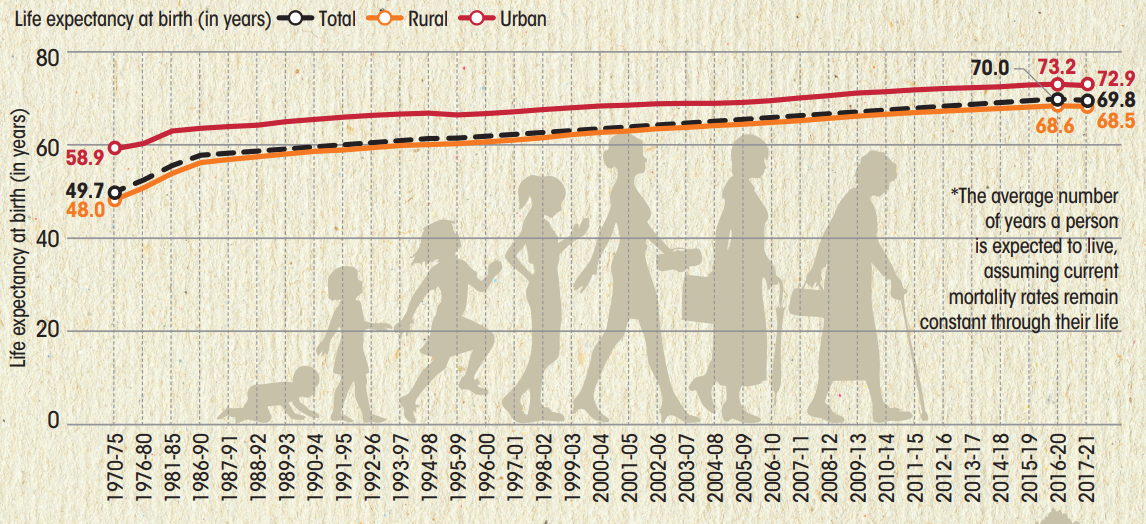
COVID-19 Likely the Cause
- Though not officially stated, the dip coincides with the peak years of the COVID19 pandemic (2020–21).
- Death rate rose from 6.0 in 2020 to 7.9 in 2021.
- Total deaths jumped from 8.1 million (2020) to 10.2 million (2021)—the sharpest rise in over five decades.
- Respiratory disease deaths surged from 181,160 to 305,191.
- Circulatory system-related deaths increased from 580,751 to 714,072.
Life Expectancy Losses Deeper Than Reported
- A study by the International Institute for Population Sciences (IIPS) found that India lost 1.6 years of life expectancy in 2021 alone.
- The gender gap widened from 2.8 to 3.2 years, erasing nearly a decade of progress.
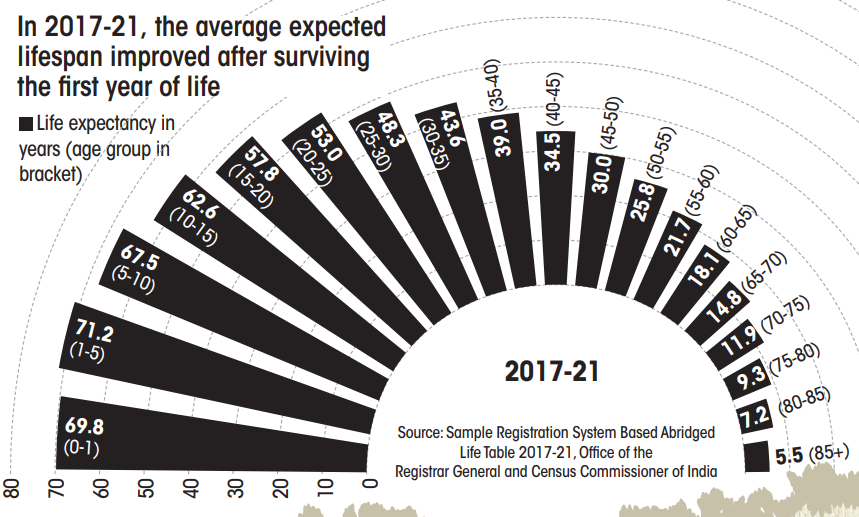
Global Context
- The UN Human Development Report (2021–2022) estimates:
- India’s life expectancy dropped from 69.7 in 2019 to 67.2 in 2021.
- 70% of countries globally experienced similar declines.
- 85% of countries also saw income reductions during the pandemic.
Lessons for the Future
- Despite economic recovery in 2021, the health crisis worsened.
- The UN warns that life expectancy reductions continued for two-thirds of countries even after the peak of the pandemic—highlighting the long-term socioeconomic impact and the need for robust post-pandemic health strategies.
Is India’s CRISPR Feat with Rice a Costly Proposition?
Context
- Recently, Indian Council of Agricultural Research (ICAR) unveiled two CRISPR-Cas edited rice varieties — DRR Dhan 100 (Kamala) and Pusa DST Rice 1 — designed to be drought-tolerant, faster-maturing, and nitrogen-efficient.
About the Clustered Regularly Interspaced Short Palindromic Repeats (CRISPR)-Cas9
- It was developed by Nobel Prize winners Jennifer Doudna and Emmanuelle Charpentier in 2012.
- It enables scientists to precisely modify DNA sequences, offering immense potential in agriculture, healthcare, and environmental conservation.
Science Behind CRISPR-Cas9
- It is a natural defense mechanism found in bacteria, allowing them to recognize and destroy viral DNA.
- Scientists have repurposed it to edit genomes in higher organisms.
- The Cas9 enzyme acts as molecular scissors, guided by RNA to target specific DNA sequences, enabling precise genetic modifications.
Applications and Advancements
- CRISPR-Cas9 has been widely used in agriculture to enhance crop resilience.
- Indian researchers at the ICAR have developed genome-edited rice varieties using CRISPR technology, making them drought-tolerant and nitrogen-efficient.
- However, concerns over licensing costs and intellectual property rights have emerged, as the technology is patented by global firms.
- In medicine, CRISPR holds promise for treating genetic disorders. Scientists at CSIRInstitute of Genomics and Integrative Biology have engineered an improved version of the FnCas9 enzyme, making gene editing more precise and efficient.
Key Comparisons With Other Gene Editing Methods
- Compared to older methods like Zinc Finger Nucleases (ZFNs) and Transcription Activator-Like Effector Nucleases (TALENs), CRISPR-Cas9 is easier to design and more cost-effective.
- Ease of Use: CRISPR-Cas9 requires only a guide RNA to target DNA, whereas ZFNs and TALENs need complex protein engineering.
- Precision: CRISPR-Cas9 offers high specificity but can have off-target effects. ZFNs and TALENs are more precise but harder to design.
- Cost & Accessibility: CRISPR is significantly cheaper and more accessible than ZFNs and TALENs, making it widely adopted.
- Efficiency: CRISPR-Cas9 enables rapid gene editing, while older methods require more time and expertise.
Potential Costs & Policy Implications
- High licensing fees could make CRISPRedited rice financially unviable for widespread adoption.
- Government intervention may be needed to subsidize licensing costs or develop indigenous gene-editing alternatives.
- Farmers’ accessibility to these improved rice varieties depends on affordable pricing and regulatory approvals.
Mhadei River
Context
- Recently, the Mhadei river was in the news following a report by the Council of Scientific and Industrial Research–National Institute of Oceanography (CSIR-NIO).
About the Mhadei River (aka Mandovi River)
- It is a west-flowing river originating in the Bhimgad Wildlife Sanctuary in Karnataka, and flows through Goa before draining into the Arabian Sea.
- It is home to several tributaries, including Kalasa and Banduri.
- It has been at the center of a decades-long dispute between Karnataka, Goa, and Maharashtra over water-sharing rights.
Tungnath Bugyal
Context
- There is a need to curb soil erosion and tourism in Tungnath Bugyal.
About the Tungnath Bugyal
- It is a high-altitude meadow located at approximately 3,600 meters above sea level in Uttarakhand's Garhwal Himalayas.
- It is known for its alpine grasses and panoramic views of peaks like Chaukhamba, Kedar Dome, and Nanda Devi.
Ecological and Aesthetic Significance
- Rich Biodiversity: The Bugyal transforms into a floral paradise, with wildflowers such as rhododendrons, primulas, and gentians carpeting the landscape during summer.
- The region supports Himalayan birds and small mammals, enriching its ecological value.
- Environmental Role:
- A carbon sink, helping to combat climate change.
- A water retention zone, regulating water flow in the mountains.
- A biodiversity hotspot, sustaining various flora and fauna.
- A support system for pastoralism, aiding traditional livelihoods.
Conservation Challenges
- Impact of Tourism: Unregulated trekking has led to:
- Trampling of vegetation.
- Creation of informal paths, which hasten erosion.
- Disturbance to wildlife and loss of vegetation cover.
- Soil Erosion: Due to the young and fragile nature of the soil:
- Monsoon rains trigger significant erosion.
- Steep slopes reduce soil accumulation.
- Unmanaged foot traffic exacerbates degradation.
- Lack of Enforcement: Though signboards prohibit shortcuts and warn of penalties, on-ground enforcement is absent.
- There is no active action plan for restoration or erosion control.
Way Forward
- Sustainable Tourism:
- Establish controlled trekking routes.
- Educate visitors on low-impact practices.
- Introduce caps on daily footfall.
- Conservation Measures:
- Implement erosion control methods like bioengineering and contour bunding.
- Strengthen forest department presence for rule enforcement.
- Develop community-based models for meadow stewardship.
Indian Gharial (Gavialis Gangeticus)
Context
- The population of Indian gharial has plummeted dramatically over the decades, making it one of the most critically endangered reptiles in the world.
About the Indian Gharial (Gavialis Gangeticus)
- It is a fish-eating crocodilian native to the Indian subcontinent; and only about 800 mature individuals remain globally.
- They show Sexual Dimorphism means males and females differ significantly in size and appearance.
- They feed exclusively on warm-blooded species and are not man-eaters, unlike crocodiles.
- It is listed as Critically Endangered by IUCN.
- It is listed under Schedule 1 of the Wild Life (Protection) Act, 1972.
Habitat Concentration
- The majority of gharials are found in India, primarily along the Chambal River, which traverses Madhya Pradesh, Rajasthan, and Uttar Pradesh.
- Several gharial breeding and rehabilitation centres came up across India.
- The most prominent ones are the National Chambal Sanctuary and the Kukrail Gharial Rehabilitation Center in Uttar Pradesh.
Major Threats
- Sand mining along riverbanks
- Hydropower projects altering natural habitats
- Human encroachment disrupting breeding grounds
Global Environment Facility (GEF)
Context
- A recent study has revealed that biodiversity funding is not reaching Indigenous Peoples and Local Communities (IPLCs) — especially women — despite their vital role in conserving ecosystems.
- Global Environment Facility (GEF) allocated 25–30% of its funds to local actors.
About the Global Environment Facility (GEF)
- It was established on the eve of the 1992 Rio Earth Summit, to provide funding to developing countries for projects that tackle biodiversity loss, climate change, pollution, and land degradation.
- It operates as a multilateral fund, supporting initiatives under six major environmental conventions which aims to protect 30% of the planet’s land and oceans by 2030.
Recent Funding Initiatives (67th GEF Council)
- $495.6 million under the GEF Trust Fund for biodiversity conservation and pollution reduction.
- $37.8 million under the Global Biodiversity Framework Fund (GBFF) to support protected areas in Brazil and Mexico.
- $203 million under the Least Developed Countries Fund (LDCF) for climate resilience projects.
- India has received $6.7 million to expand its protected area network and $10.7 million for conservation efforts along the Central Asian Flyway.
Public Database Tracking Climate Disasters
Context
- The National Oceanic and Atmospheric Administration (NOAA) has announced its decision to retire its Weather and Climate Disasters database, a widely used tool for tracking the financial impact of extreme weather events.
Key Features of the Database
- Historical Records (1980–2024): NOAA documented 403 billion-dollar disasters, with total costs exceeding $2.9 trillion.
- It recorded disasters that caused at least $1 billion in damages, providing valuable insights into climate trends and economic losses.
- Annual Tracking: In 2024, the U.S. experienced 27 billion-dollar disasters, including hurricanes, wildfires, and severe storms.
- Data Sources: The database compiled information from FEMA, state agencies, and insurance organizations to estimate disaster costs.
Concerns Over NOAA’s Decision to Retire the Database
- Loss of a Key Climate Tool: The database was widely used by government agencies, researchers, and insurers to assess climaterelated financial risks.
- Rising Disaster Costs: With climate change intensifying extreme weather events, experts argue that tracking financial impacts is more important than ever.
- Alternative Data Sources: While other datasets exist, they often lack the scope and detail of NOAA’s database.
Shrinking Swiss Glaciers Enter Summer with Low Snow Cover
Context
- According to a report by Glacier Monitoring Switzerland (Glamos), the depth of snow on Swiss glaciers was 13% lower than the 2010–2020 average.
Why Is Snow Cover Important?
- Snow cover plays a crucial role in protecting glaciers from heat and sunlight.
- During winter, snowfall replenishes the glaciers, forming a protective layer that slows down melting in the warmer months.
- However, this year’s low snow accumulation leaves glaciers more vulnerable to rapid melting, potentially contributing to global sea-level rise.
Impact of Climate Change
- Swiss glaciers lost 10% of their volume in 2022 and 2023 alone, marking one of the fastest rates of glacial retreat in recorded history.
- Last summer, despite good snowfall, glaciers still lost 2.4% of their volume due to high temperatures and dust deposition from the Sahara Desert, which reduced their ability to reflect sunlight.
Prohibiting Retrospective Environmental Clearances, Scraps Government Notifications
Context
- Recently, the Supreme Court of India has barred the government from granting retrospective environmental clearances (ECs), striking down previous Office Memorandums (OMs) that allowed industries and infrastructure projects to seek approval after operations had already begun.
- It bars the Union government from granting ex post facto ECs to projects that violated the Environment (Protection) Act, 1986, and the Environmental Impact Assessment (EIA) Notification, 2006.
About the Environmental Clearances (ECs)
- These are a regulatory mechanism designed to ensure that industrial and infrastructure projects comply with environmental standards before they commence operations.
- In India, these clearances are governed by the Environment Impact Assessment (EIA) Notification, 2006, which mandates prior approval for projects that could significantly impact the environment.
- Process of ECs:
- Screening and Scoping: Identifying potential environmental risks.
- Public Consultation: Gathering feedback from affected communities.
- Expert Appraisal: Reviewing environmental impact reports before granting approval.
- Role of Office Memorandums (OMs): OMs issued by the MoEFCC provide administrative guidelines for implementing environmental policies.
- However, some OMs have been controversial, particularly those allowing retrospective environmental clearances—a practice where projects that began without prior approval could later seek regularization.
Challenges in Environmental Governance
- Loopholes in policy implementation allowing unauthorized projects.
- Conflicts between development and environmental conservation.
- Jurisdictional complexities in regulating large-scale industrial activities.
Implications of the Ruling
- Strengthens Environmental Governance: Ensures that industries comply with environmental regulations before starting operations.
- Discourages Regulatory Evasion: Sends a strong message against regularizing illegal industrial activities post-facto.
- Protects the Right to a Clean Environment: Upholds Article 21 of the Constitution, reinforcing citizens' right to a pollution-free environment.
Stockholm Convention
Context
- Recently, the Conference of the Parties (COP) to the Stockholm Convention was held at Geneva, Switzerland.
About the Stockholm Convention
- It is a global treaty aimed at reducing and eliminating the production, use, and release of Persistent Organic Pollutants (POPs)— chemicals that pose serious environmental and health risks.
- It was adopted in 2001 and entered into force in 2004, with the goal of protecting human health and the environment from hazardous substances.
Challenges in Environmental Governance
- Elimination & Restriction: The treaty bans or restricts the use of harmful chemicals such as DDT, polychlorinated biphenyls (PCBs), and dioxins.
- Global Cooperation: Countries work together to phase out POPs, promote safer alternatives, and manage contaminated sites.
- Scientific Review: The convention continuously evaluates new chemicals for inclusion in its list of restricted substances.
- Support for Developing Nations: Financial and technical assistance is provided to help countries transition away from harmful chemicals.
Recent Conference of the Parties (COP) in Geneva
- Nearly 200 countries, including India, agreed to allow the use of UV-328 in the aerospace and defence sector. UV-328, in use since the 1970s, protects plastics and paints from sunlight but is toxic to the liver and endocrine system.
- UV-328 is a chemical compound, specifically a phenolic benzotriazole, used as a UV absorber in various products like plastics, coatings, and personal care items.
- Three new POPs were added under Annex A:
- Chlorpyrifos (neurotoxic insecticide)
- Long-chain Perfluorocarboxylic Acids (LC-PFCAs) (linked to cancer)
- Medium-chain Chlorinated Paraffins (MCCPs) (harmful to liver, kidneys, thyroid)
- India’s Limited Participation: India has not ratified most updates to Annex A.
- India had implemented bans on only 7 out of 33 listed chemicals, as of 2021.
- Like 20 other nations, India’s opt-in stance allows it to delay or ignore new amendments.
Subjective Questions for Practise
Q1. Despite a surge in registrations under MGNREGA, employment generation has declined significantly. What systemic and policy-level challenges contribute to this disconnect, and how can they be addressed to ensure the scheme fulfills its intended purpose?
Q2. The Indian government has approved the use of millions of tonnes of rice for ethanol production, aiming to reduce fossil fuel dependence. In your opinion, how should policymakers balance the need for sustainable energy with ensuring food availability?
Q3. How can ecotourism be structured to ensure both wildlife protection and sustainable local development?
Q4. Artificial pollination is increasingly being used in India to counter declining pollinator populations. How should India balance technological intervention with natural pollination conservation?
QUICK LINKS